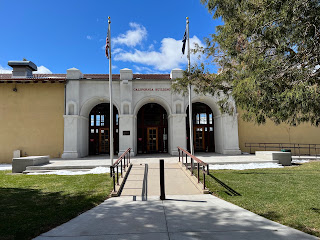 |
| Reno's Historic Idlewild Park |
 |
| The California Building in Idlewild Park |
Reno’s Idlewild Park, which sits on the edge of the Truckee River, just west of the downtown, has long been a sanctuary for the city’s residents.
The park site, in fact, can trace its roots to the late 19th and early 20th century, when it was apparently part of several ranches. In 1907, the land was purchased by the Newlands Company, which developed the Newlands Heights neighborhood.
In 1923, as Reno city officials were beginning to show interest in civic projects that could improve the lives of residents, the 49-acre site was sold to the city of Reno for a park (for $23,500).
That same year, the Nevada State Journal conducted a contest to name the park, with the winner receiving a $25 prize. Upon selected winning entry, Idlewild Park, Reno Mayor Edwin E. Roberts told the newspaper that he approved of the name because he had “never seen anybody doing any work out there, and it sure as hell is wild!”
One of the big attractions in the early days of the park was an old log cabin, moved to the park in 1924, which was alleged to have been writer Mark Twain’s abode in Aurora in the early 1860s.
Reno historian Patty Cafferata has written that the cabin was moved to Reno from the old mining camp of Aurora after Nevada officials found that California wanted to move it to their state (Aurora is located right on the boundary between the two states).
According to Cafferata, the cabin was dismantled and moved to the park in two large trucks, then reassembled.
While the cabin remained a popular attraction for several decades, by 1940, the Work Projects Administration Guide to Nevada described as sad, forlorn and neglected. Cafferata said that, sadly, in 1945, picnickers began removing pieces from the cabin to use for firewood and it quickly disappeared.
The other, more lasting landmark in Idlewild Park is a large building known as the California Building, which was erected in 1926-27. The structure, which is still in use, was a gift from the state of California for the Transcontinental Highways Exposition of 1927, which celebrated the completion of the Lincoln and Victory Highways across the country (Reno was where the roads converged).
California dedicated two years and more than $100,000 for the building and related displays and exhibitions.
The California Building was constructed in the Mission Revival architectural style with stucco walls, a clay tile roof, a bell tower and arched windows. When it opened, it was dedicated to those who died in World War I.
Following the exhibition, the building was deeded to the local American Legion post, which, in 1938, donated it to the city of Reno.
In addition to the California Building, Idlewild Park, which remains one of the city’s most popular parks, boasts a large and beautiful rose garden, ball fields, a municipal swimming pool, the Lion Arch Playground, two large ponds and lots of trees. In fact, a self-guided walking tour of the trees is available for download (https://issuu.com/cityofreno/docs/idlewildparktrees-selfguidedwalking).
In the summer months, the park offers a train ride for children, which was always a popular attraction for my kids when they were young.
For more information about Idlewild Park, go to: https://www.tmparksfoundation.org/parks/idlewild-park.






